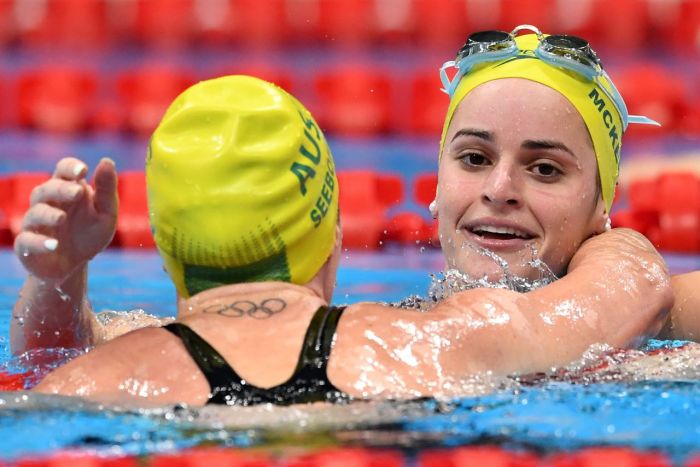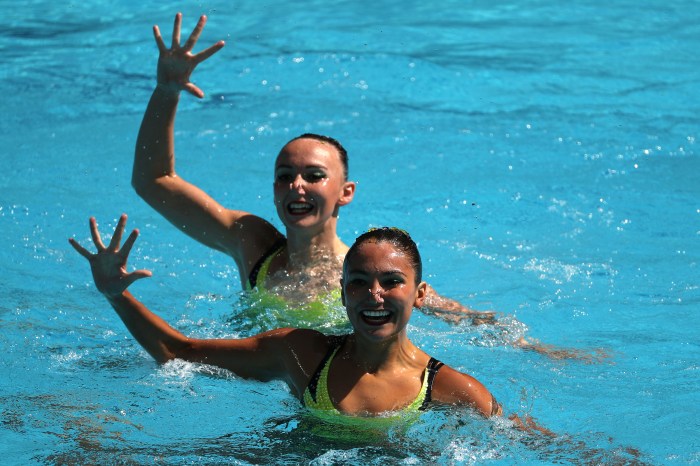As Artistic Swimming Olympics Australia takes center stage, this opening passage beckons readers with liputan6 author style into a world crafted with good knowledge, ensuring a reading experience that is both absorbing and distinctly original. From the shores of Australia, artistic swimmers have etched their names in Olympic history, showcasing the nation’s prowess in this captivating aquatic art form.
Artistic swimming, a mesmerizing blend of athleticism, artistry, and grace, has captivated audiences worldwide. In Australia, the sport has flourished, producing exceptional athletes who have left an indelible mark on the Olympic stage. With a rich history, dedicated training programs, and unwavering passion, artistic swimming in Australia continues to soar to new heights.
Overview of Artistic Swimming in Australia
Artistic swimming, also known as synchronized swimming, has a rich history and growing popularity in Australia. The sport combines swimming, acrobatics, and dance, creating visually stunning performances. Artistic swimming in Australia has witnessed significant development over the years, with a strong national team and numerous successful athletes.
The sport gained recognition in Australia in the early 20th century, with the first national championships held in 1934. Since then, artistic swimming has grown steadily, with the establishment of clubs and training facilities across the country. Today, Australia boasts a strong presence in the international arena, consistently ranking among the top nations in competitions.
Artistic swimming in Australia is governed by the Australian Swimming Coaches and Teachers Association (ASCTA), which provides training programs, competitions, and support for athletes and coaches. The sport enjoys a wide participation base, with thousands of registered athletes competing in various levels of competitions.
Australian Olympic Success in Artistic Swimming

Australia has a proud history of success in artistic swimming at the Olympic Games. The Australian team has participated in every Olympics since 1984, consistently achieving impressive results.
- 1996 Atlanta Olympics:The Australian team won the bronze medal in the team event, marking the country’s first Olympic medal in artistic swimming.
- 2000 Sydney Olympics:The Australian team repeated their bronze medal performance in the team event, showcasing their technical and artistic prowess on home soil.
- 2004 Athens Olympics:The team once again secured a bronze medal in the team event, demonstrating their consistency and resilience.
- 2008 Beijing Olympics:The Australian team finished fourth in the team event, narrowly missing out on a podium finish.
- 2012 London Olympics:The team achieved their best Olympic result to date, winning the silver medal in the team event. This was a significant achievement, highlighting the team’s exceptional talent and dedication.
- 2016 Rio Olympics:The Australian team maintained their strong performance, finishing fourth in the team event, showcasing their continued competitiveness at the highest level.
Notable Australian artistic swimmers who have contributed to the country’s Olympic success include:
- Libby Trickett:A multiple Olympic medalist in swimming, Trickett also competed in artistic swimming at the 2004 Athens Olympics.
- Eloise Amberger:A member of the Australian team that won the silver medal at the 2012 London Olympics.
- Bianca Hammett:Another member of the silver-medal-winning team at the 2012 London Olympics.
Training and Development Programs

Australia has a comprehensive system of training and development programs for artistic swimmers. The ASCTA, in collaboration with state and regional organizations, provides a structured pathway for athletes to progress from grassroots to elite levels.
National Training Centre:The Australian Institute of Sport (AIS) in Canberra serves as the National Training Centre for artistic swimming. The AIS provides world-class facilities, expert coaching, and support services for elite athletes.
State and Regional Programs:State and regional organizations also play a crucial role in the development of artistic swimmers. They offer training programs, competitions, and coaching support to athletes at various levels.
Scholarships and Grants:The ASCTA and other organizations provide scholarships and grants to support the training and development of promising artistic swimmers. These financial incentives help athletes cover the costs of training, travel, and equipment.
Artistic Swimming Techniques and Choreography
Artistic swimming combines technical elements and artistic components to create visually stunning performances. The technical elements include:
- Body positions:Artistic swimmers perform various body positions, such as vertical, horizontal, and upside-down, while maintaining control and balance.
- Legwork:Legwork is an essential component of artistic swimming, providing propulsion and support for the upper body.
- Arm movements:Arm movements are used to create graceful and expressive patterns, adding to the overall aesthetic appeal.
The artistic components of artistic swimming include:
- Choreography:Artistic swimmers create and perform routines that are set to music. The choreography must be original, innovative, and well-executed.
- Music selection:The music used in artistic swimming routines is carefully chosen to complement the choreography and enhance the overall performance.
- Expression:Artistic swimmers strive to convey emotions and tell stories through their performances, using their movements and expressions.
Challenges and Opportunities: Artistic Swimming Olympics Australia
Like any sport, artistic swimming in Australia faces certain challenges. One challenge is the relatively low profile of the sport compared to other aquatic disciplines, such as swimming and diving. This can limit media coverage and public awareness.
Despite these challenges, there are also opportunities for growth and development in artistic swimming in Australia. The sport has the potential to attract new participants and gain wider recognition through initiatives such as:
- Promotion and outreach programs:ASCTA and other organizations can implement initiatives to promote artistic swimming at schools, community centers, and other venues.
- Increased media coverage:Increased media attention can help raise the profile of the sport and attract new viewers.
- Collaboration with other sports:Artistic swimming can benefit from collaboration with other sports, such as swimming and dance, to share knowledge and resources.
Related Topics
Artistic swimming is closely related to other aquatic sports, such as swimming and diving. It shares elements of swimming, such as propulsion and body control, and incorporates elements of dance, such as grace and expression.
Artistic swimming also promotes physical fitness and well-being. It requires a high level of cardiovascular fitness, strength, and flexibility. The sport also helps develop coordination, balance, and spatial awareness.
In addition to the physical benefits, artistic swimming can also provide psychological benefits. It can help improve self-confidence, teamwork, and discipline.
End of Discussion

The journey of artistic swimming in Australia is a testament to the dedication, perseverance, and artistry of its athletes, coaches, and supporters. As the sport continues to evolve, Australia remains a beacon of excellence, inspiring future generations to embrace the beauty and challenges of artistic swimming.
With unwavering determination and a commitment to pushing boundaries, Australia’s artistic swimmers will undoubtedly continue to grace the Olympic stage with their captivating performances.
Frequently Asked Questions
What is the history of artistic swimming in Australia?
Artistic swimming, formerly known as synchronized swimming, has a rich history in Australia, dating back to the early 20th century. The sport gained prominence in the 1950s and has since produced numerous Olympic medalists.
Who are some of the most successful Australian artistic swimmers?
Australia has produced several world-renowned artistic swimmers, including Petria Thomas, Lisa Curry-Kenny, and Danielle Kettlewell. These athletes have won numerous Olympic medals and set world records.
What are the challenges facing artistic swimming in Australia?
Artistic swimming faces challenges such as limited funding, competition from other sports, and the need for specialized training facilities. However, the sport continues to grow in popularity and attract new participants.